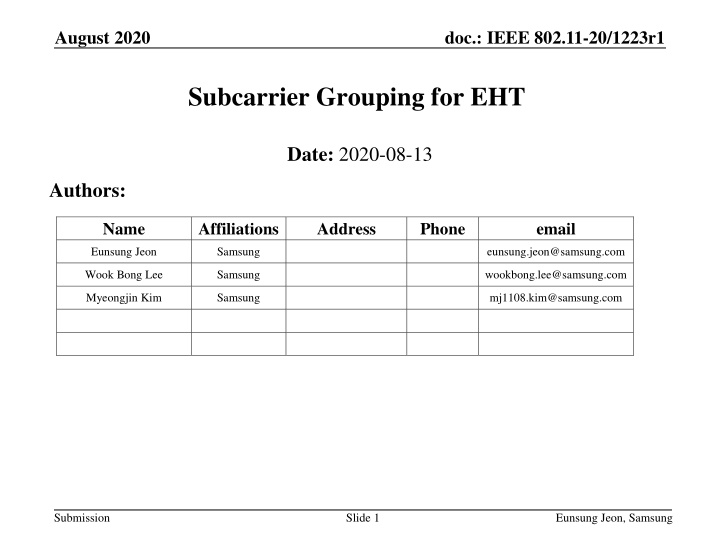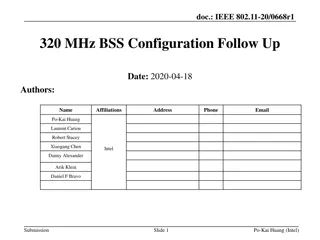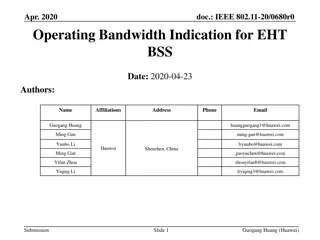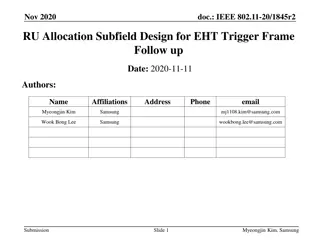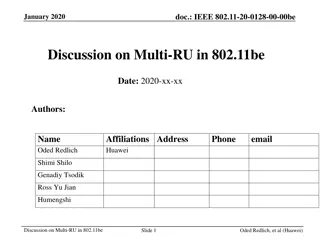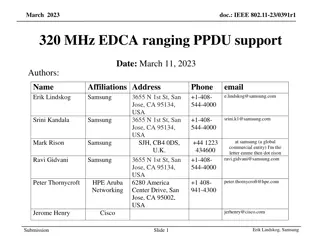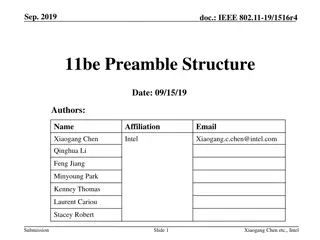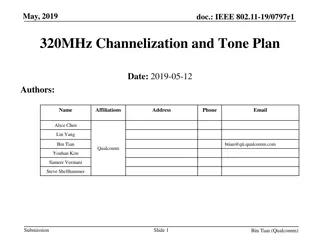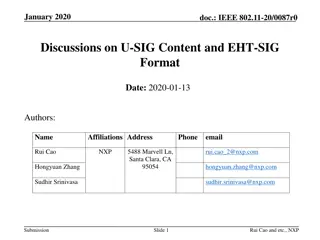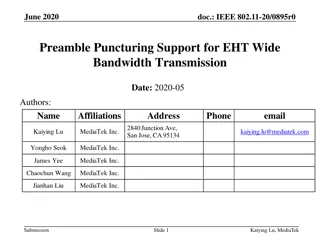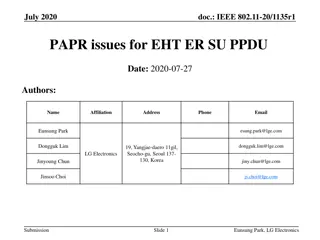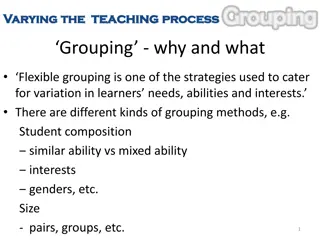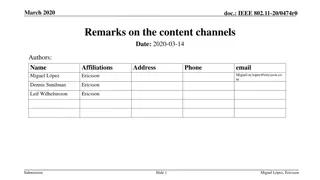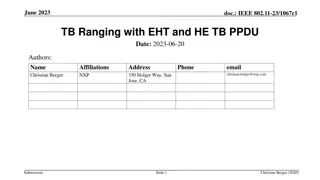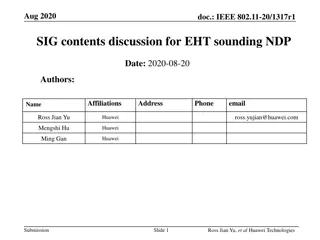Subcarrier Grouping for EHT
In this document dated August 2020, Samsung presents a proposal for subcarrier grouping in IEEE 802.11be standard to reduce feedback overhead. The proposal includes subcarrier grouping sizes for various scenarios like SU, MU, VHT, and HE. Simulation parameters and performance analysis for SU-MIMO are also discussed. The document emphasizes the importance of choosing the right subcarrier grouping size for optimal performance in different scenarios.
Download Presentation

Please find below an Image/Link to download the presentation.
The content on the website is provided AS IS for your information and personal use only. It may not be sold, licensed, or shared on other websites without obtaining consent from the author.If you encounter any issues during the download, it is possible that the publisher has removed the file from their server.
You are allowed to download the files provided on this website for personal or commercial use, subject to the condition that they are used lawfully. All files are the property of their respective owners.
The content on the website is provided AS IS for your information and personal use only. It may not be sold, licensed, or shared on other websites without obtaining consent from the author.
E N D
Presentation Transcript
August 2020 doc.: IEEE 802.11-20/1223r1 Subcarrier Grouping for EHT Date: 2020-08-13 Authors: Name Affiliations Address Phone email Eunsung Jeon Samsung eunsung.jeon@samsung.com Wook Bong Lee Samsung wookbong.lee@samsung.com Myeongjin Kim Samsung mj1108.kim@samsung.com Submission Slide 1 Eunsung Jeon, Samsung
August 2020 doc.: IEEE 802.11-20/1223r1 Introduction 802.11be shall supports that [1] Wideband band and noncontiguous spectrum utilization Large size RU combination assigned to a single STA. Maximum 16 spatial streams Beamforming feedback overhead is significantly increased, compared to 11ax [2] In order to reduce feedback overhead, the subcarrier grouping method was adopted in 11ac and 11ax In this slide, we propose the subcarrier grouping size (Ng) for 802.11be Submission Slide 2 Eunsung Jeon, Samsung
August 2020 doc.: IEEE 802.11-20/1223r1 Recap: Subcarrier grouping Subcarrier grouping Only a single compressed beamforming feedback matrix is reported for each group of Ng adjacent subcarriers. Feedback overhead reduction vs. channel information accuracy By using the grouping method, we can reduce the feedback overhead (i.e., total length of CBR frame) However, the channel information becomes inaccuracy Subcarriers for which CBR is feedback Ng=4 Frequency Submission Slide 3 Eunsung Jeon, Samsung
August 2020 doc.: IEEE 802.11-20/1223r1 Subcarrier grouping size (Ng) for EHT Proposal of Ng for EHT SU MU VHT HE EHT 1, 2, 4 4, 16 16, 32 4, 8 Subcarrier spacing for VHT: 312.5 KHz Subcarrier spacing for HE and EHT: 78.125 KHz The reason for the proposal In most HE SU-MIMO cases, we observed that there was little PER performance difference between Ng=4 and Ng=16 In most HE MU-MIMO cases, we observed that there was large PER performance difference between Ng=4 and Ng=16 Submission Slide 4 Eunsung Jeon, Samsung
August 2020 doc.: IEEE 802.11-20/1223r1 Simulation parameters Parameter Value Frame format HE Packet size 4,096 byte Channel model B, D Impairment Freq. offset: 20 PPM Channel coding LDPC Channel estimation LS (w/o smoothing) GI+LTF Size 4x HE-LTF and 3.2 s GI Number of transmit antennas (Ntx) Number of receive antennas (Nrx) Number of spatial antennas (Nss) Number of users 3, 4, 6, 8 1, 2 1, 2 1, 2, 3, 4 Codebook information Fine codebook MCS 2, 4, 6, 8, 10 Submission Slide 5 Eunsung Jeon, Samsung
August 2020 doc.: IEEE 802.11-20/1223r1 PER for SU-MIMO (4 ?) [Channel B] [Channel D] Channel B Performance is almost same for Ng=4, Ng=16 and Ng=32 Channel D Compared with Ng=4, performance loss for Ng=16 is negligible Compared with Ng=4, performance loss for Ng=32 is < 0.5dB at PER=0.1 Slide 6 Submission Eunsung Jeon, Samsung
August 2020 doc.: IEEE 802.11-20/1223r1 PER for SU-MIMO (4 ?) [Channel B] [Channel D] Channel B Performance is almost same for Ng=4, Ng=16 and Ng=32 Channel D Compared with Ng=4, performance loss for Ng=16 is negligible Compared with Ng=4, performance loss for Ng=32 is < 1.0dB at PER=0.1 Slide 7 Submission Eunsung Jeon, Samsung
August 2020 doc.: IEEE 802.11-20/1223r1 PER for MU-MIMO (4 ?) [Channel B] [Channel D] Channel B Performance is almost same for Ng=4 and Ng=8 Channel D Performance loss for Ng=16 is significantly large, especially for high MCS Performance loss for Ng=8 is < 0.5dB at PER=0.1 Slide 8 Submission Eunsung Jeon, Samsung
August 2020 doc.: IEEE 802.11-20/1223r1 PER for MU-MIMO (4 ?) [Channel B] [Channel D] Channel B Performance is almost same for Ng=4 and Ng=8 Channel D Performance loss for Ng=16 is significantly large, especially for high MCS Performance loss for Ng=8 is < 0.5dB at PER=0.1 Slide 9 Submission Eunsung Jeon, Samsung
August 2020 doc.: IEEE 802.11-20/1223r1 Feedback overhead reduction for SU Feedback overhead reduction is approximately same as the CBR size reduction CBR size can be calculated by 16 + ?? (??+ ??)/2 ???(bits) [1] Assuming 8x2, 40MHz, fine codebook, then ?? = 26 ?? = 6, ??= 4 ??? = 122, 62, 32, 17 for Ng = 4, 8, 16, 32 respectively Ng 4 8 16 522 32 278 CBR size (byte) Reduction compared with Ng=4 1985 1010 0% 49% 74% 86% Submission Slide 10 Eunsung Jeon, Samsung
August 2020 doc.: IEEE 802.11-20/1223r1 Summary In this slide, we propose the subcarrier grouping size (Ng) for 802.11be Proposal of Ng for EHT SU MU VHT HE EHT 1, 2, 4 4, 16 16, 32 4, 8 Subcarrier spacing for VHT: 312.5 KHz Subcarrier spacing for HE and EHT: 78.125 KHz Submission Slide 11 Eunsung Jeon, Samsung
August 2020 doc.: IEEE 802.11-20/1223r1 Reference [1] 802.11-20/0566r23, Specification Framework for TGbe. [2] 802.11-19/0828r4, Feedback Overhead Analysis for 16 Spatial Stream MIMO [3] IEEE P802.11ax, Part 11: Wireless LAN Medium Access Control (MAC) and Physical Layer (PHY) specifications. Amendment 1: Enhancements for High Efficiency WLAN, Feb. 2019. Submission Slide 12 Eunsung Jeon, Samsung
August 2020 doc.: IEEE 802.11-20/1223r1 SP #1 Do you agree that 802.11be supports a separate set of Ng values for SU-MIMO and MU-MIMO, respectively? Note: Ng values are TBD. Y / N / Abstain Submission Slide 13 Eunsung Jeon, Samsung
August 2020 doc.: IEEE 802.11-20/1223r1 SP #2 Do you agree that 802.11be supports Ng = 16, 32 for sounding feedback with SU-MIMO? Y / N / Abstain Submission Slide 14 Eunsung Jeon, Samsung
August 2020 doc.: IEEE 802.11-20/1223r1 SP #3 Do you agree that 802.11be supports Ng = 4, 8 for sounding feedback with MU-MIMO? Y / N / Abstain Submission Slide 15 Eunsung Jeon, Samsung
August 2020 doc.: IEEE 802.11-20/1223r1 APPENDICES Submission Slide 16 Eunsung Jeon, Samsung
August 2020 doc.: IEEE 802.11-20/1223r1 PER for SU-MIMO (6 ?, 8 ?,??.?,??.?) Submission Slide 17 Eunsung Jeon, Samsung
August 2020 doc.: IEEE 802.11-20/1223r1 PER for SU-MIMO (6 ?, 8 ?, ??.?,??.?) Submission Slide 18 Eunsung Jeon, Samsung
August 2020 doc.: IEEE 802.11-20/1223r1 PER for MU-MIMO (3 ?, 4 ?,??.?,??.?) Submission Slide 19 Eunsung Jeon, Samsung
August 2020 doc.: IEEE 802.11-20/1223r1 PER for MU-MIMO (3 ?, 4 ?,??.?,??.?) Submission Slide 20 Eunsung Jeon, Samsung
